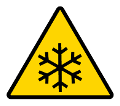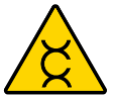Safe handling of Hazardous Materials
1/27
There's no tags or description
Looks like no tags are added yet.
Name | Mastery | Learn | Test | Matching | Spaced |
|---|
No study sessions yet.
28 Terms
Toxic
Acutely harmful to health
Cytotoxic
acutely harmful to cells
Embryotoxic
Acutely harmful to embryos/foetuses
Mutagenic
Capable of changing genetic material
Carcinogenic
Capable of directly causing cancer
Teratogenic
Causes malformations in embryos/foetus
Harm vs Risk
Harm - is an adverse outcome or impact.
Risk - is the matrixed combination of severity & likelihood.
Define the terms:
Biological
Chemical
Physical
Psychosocial
In relation to hazardous materials
Biological. Harmful organic substances, e.g. proteins or blood
Chemical. Harmful inorganic substances, e.g. bleach, 5-FU
Physical. Harmful environmental factors e.g. Pressure, noise, radiation, poor ergonomics and unsafe work areas
Psychosocial. Not Bio/Chem/Phys but have an adverse effect on wellbeing, e.g. harassment, low control, workload & bad culture
Sign for cryogenic

Sign for Carcinogenic

Sign for biological

When are drugs classed and handled as hazardous?
If drugs meet one or more of the following criteria:
Carcinogenicity
Teratogenicity
Reproductive toxicity
Organ toxicity at low doses
Genotoxicity (Older Cytotoxics)
HASWA
Helath and Safety at work act - 1974
PPEWR
Personal Protective equipment at work regulations - 1992
COSHH
Control of substances hazardous to health - 2002
Potential routes of exposure
Ingestion (Consuming)
Inhalation (Breathing)
Dermal (Absorption through skin)
Mucosal membranes (moist lining of organs & cavities)
Percutaneous (needle puncture)
Personnel that would be affected by exposure
As well as these personnel, carers and relatives would be affected
manufacture
transport
stores
reception
dispensing
administration
nursing
Reproductive Risk
increased risk of premature delivery
longer time to conceive
low birth weight
Latency periods
The latency period following exposure may be years
Which surfaces can be contaminated?
Vial surface
Product surface
Work surface
All of these can be contaminted
Air contamination
Using containment exhausts can be contaminated as the recirculated air can sometimes have the contaminants
Hierarchy of Control
assess risk
eliminate (removing the exposure before it can occur)
substitute (removing the exposure before it can occur)
engineering control - change/adapt the environment
admin controls - require someone to do something
PPE
Using Substitution to manage risk
Substitute powders with liquids
Removal of reconstitution step
Substitute standard needles with
Luer-lock fittings
Vented needles
Compounding spikes
Vials versus ampoules
Using engineering controls to manage risk
Based on two aspects:
Product protection
Operator protection (PPE)
General changes we do:
Well designed rooms
Smooth, easy to clean surfaces and furniture
Environmental control
Minimal objects and storage within
Type of ventilated cabinet:
–LAFCs vs BSC vs isolators
–Positive or negative pressure
–Flexible vs rigid materials
Material decontamination
Administrative control to manage risks
education and training
Only trained staff can handle hazardous materials
procedures
clear and unambiguous written SOPs
minimum staff numbers to ensure safe working
surveillance and supervision
adherence to safe handling to safe handling techniques
PPE
PPE is the final barrier between operators and hazards/products
Multiple light layers best as opposed to thick heavy layer which can impede movement and be uncomfortable
Decontamination
Removal
Aqueous clean
Detergent
Validated method
Denaturation
Biologics
Bleach or alkaline agents
PPE Gloves
Latex
Vinyl - reduced barrier protection due to its susceptibility to tears, breakage and pinholes compared to latex.
Nitrile - good tear resistance and chemical resistance although cost more than either latex or vinyl.
Neoprene - comfort but is also more expensive than latex.
Polyurethane - good comfort and tactile sensitivity as well as puncture, tear and abrasion resistance. However, expensive